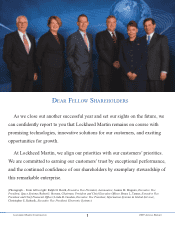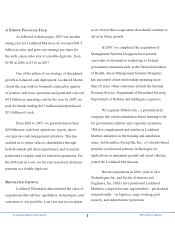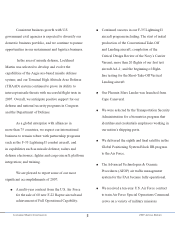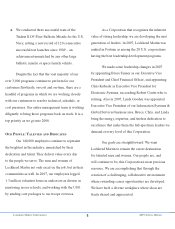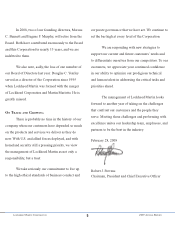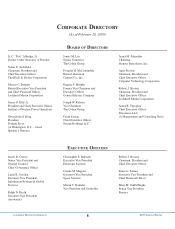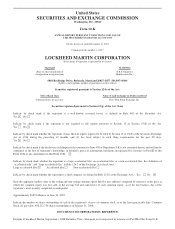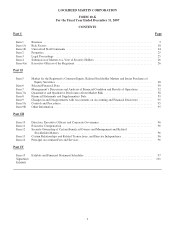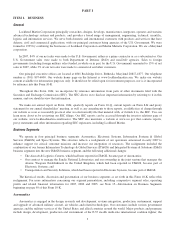Lockheed Martin 2007 Annual Report Download - page 13
Download and view the complete annual report
Please find page 13 of the 2007 Lockheed Martin annual report below. You can navigate through the pages in the report by either clicking on the pages listed below, or by using the keyword search tool below to find specific information within the annual report.The F-35 is planned to replace the F-16 and A-10 for the U.S. Air Force, the F/A-18A/C for the U.S. Navy, the AV-8B
and F/A-18A/C/D for the U.S. Marine Corps, and the Harrier GR.7 and Sea Harrier short takeoff and vertical landing attack
aircraft for the United Kingdom Royal Air Force and Royal Navy.
Aeronautics was awarded the SDD contract for the F-35 in the fourth quarter of 2001. Calendar-year 2007 marked the
sixth full year of performance on the planned 12-year development contract. Testing of airworthiness and systems evaluation
using the first F-35 CTOL aircraft continued in 2007, and component production has begun on all of the remaining SDD
flight test aircraft (all variants) and both CTOL production aircraft in Low Rate Initial Production Lot 1. The first STOVL
test airplane moved from the factory to the flight line in December 2007 and, after extensive ground testing, is expected to fly
mid-year 2008. The first flight of the CV aircraft is planned to occur in the 2009 timeframe.
Given the size of the F-35 program, we anticipate that there will be a number of studies related to the program schedule
and production quantities over time as part of the normal DoD, Congressional and international partners’ oversight and
budgeting processes.
F-22
We are the industry team leader for the F-22 Raptor. In production since 1997, the F-22 has unmatched capabilities
compared with other operational U.S. Air Force aircraft. The capabilities include enhanced maneuverability, stealth,
supercruise speed (speed in excess of Mach 1.5 without afterburner) and advanced integrated avionics that enable pilots to
attack critical air and surface targets to gain and maintain air superiority against air-to-air and ground-to-air threats. The
program is in full-rate production. Through 2007, a total of 110 F-22s have been delivered to the U.S. Air Force, including 24
Raptors delivered during 2007. In 2007, we received a 60-aircraft multi-year contract for Production Lots 7, 8 and 9. At
December 31, 2007 there were 81 F-22s in backlog.
In 2007 we began delivering F-22s to the third operational squadron, the 90th Fighter Squadron at Elmendorf Air Force
Base (AFB), Alaska, and we expect to deliver the first aircraft for the fourth operational unit, the 8th Fighter Squadron at
Holloman AFB, New Mexico, in mid 2008. Also in 2007, the Raptor completed its deployment to Kadena Air Base, Japan,
its first such deployment outside the U.S. and second deployment overall. The Raptor also participated in its first “Red Flag”
exercise, a large-scale force-on-force exercise designed to prepare joint forces to respond to crises around the world. During
the exercise, F-22s demonstrated exceptional performance, ensuring air dominance and enhancing the success of combat
commanders by providing improved situational awareness for other ground and air assets. In December 2007, the U.S. Air
Force declared Full Operational Capability for the F-22.
F-16
We produce the F-16 Fighting Falcon multi-role tactical fighter aircraft and continue to provide upgrades and support
for the U.S. Air Force and our international customers. From the program’s inception in the mid-1970s through 2007, 4,389
F-16s have been delivered worldwide, representing nearly 30 years of continuous production deliveries. As of year-end 2007,
the aircraft had been selected by 24 countries, with 52 follow-on buys by 14 of these countries.
In 2007, a total of 41 F-16 aircraft were delivered worldwide. In July 2007, an Undefinitized Contractual Action (UCA)
was signed for the foreign military sales procurement of 30 new F-16 Block 50 aircraft to the Government of Turkey.
Backlog at year end was 107 F-16 aircraft, including the 30 aircraft under the Turkey UCA.
Many technologically advanced multi-role capability improvements have been incorporated into new F-16 production
aircraft as well as modification programs for in-service aircraft. Air-to-air and precision attack capabilities have been
improved through the inclusion of new systems, sensors and weapons. Advanced electronic warfare systems have improved
survivability. New fuel tank configurations have increased range and endurance. Modernized, upgraded engines have
increased aircraft performance and improved supportability. Advanced communication links have given the F-16 network-
centric warfare capabilities.
Other Combat Aircraft
We also participate in joint production of the F-2 fighter aircraft, and are a co-developer of the T-50 supersonic jet
trainer aircraft.
5


